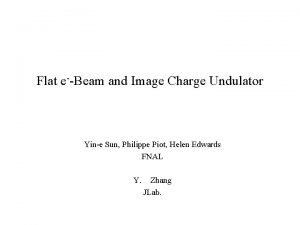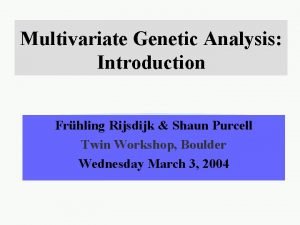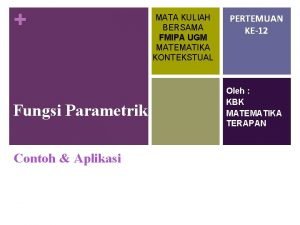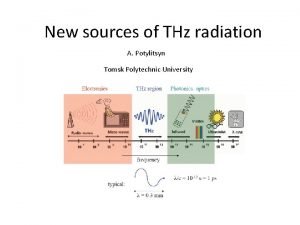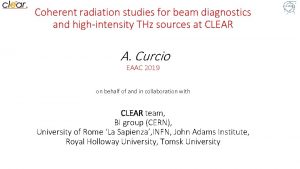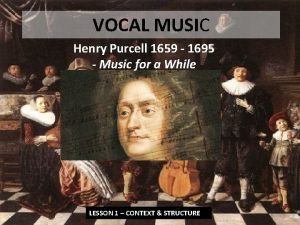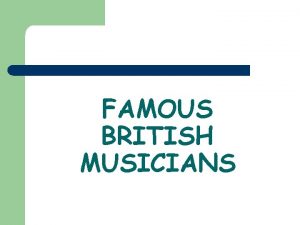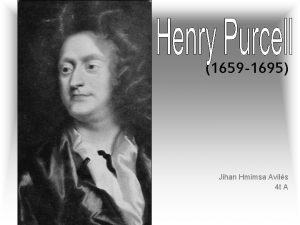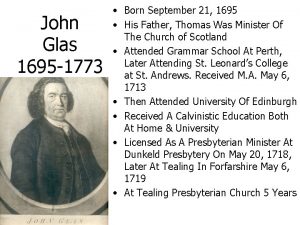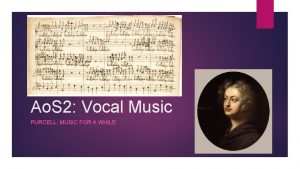Purcell 1659 1695 Music for a While https









- Slides: 9

Purcell 1659 -1695 ‘Music for a While’ https: //www. youtube. com/watch? v=BCy_u. GGn 7 i 0

‘Music For a While’ by Purcell

‘Music For A While’ was written for the Theatre • Henry Purcell (1659 -1695) was one of the most famous composers of the Baroque period (1600 -1750). • He wrote sacred choral music, chamber music, orchestral music and music for theatre. • His pieces for theatre include both opera and incidental music (songs and instrumental music performed as part of a play). • ‘Oedipus’ was a play by the English dramatist John Dryden – it was based on a story by the Greek writer Sophocles. Purcell wrote the incidental music for ‘Oedipus’. • ‘Music For a While’ is the second of four movements that Purcell wrote for ‘Oedipus’. • It is sung by a priest who is attempting to summon the ghost of a dead king.

‘Music For A While’ has a Ground Bass • The song is written for a soprano singer with continuo. • The continuo part is usually made up of two instruments – often the cello and harpsichord, which read from the same part. • In ‘Music For a While’ the continuo is made up of a bass viol and harpsicord. • In the song, Purcell uses a ground bass. This is a repeating melodic phrase in the bass part, similar to a bass guitar riff. • * In ‘Music For a While’ the ground bass is 3 bars long. This is unusual for a piece in 4/4 – you’d expect the ground bass to be 2, 4, or 8 bars long. • Listen to the ground bass played by your teacher – bars 1 -3. • * The ground bass is frequently chromatic – there is often a rise between two consecutive notes, e. g. F# to G in bar 1.

‘Music For A While’ has a Ground Bass • The shape of the ground bass melody is generally ascending. • The ascending shape of the ground bass is contrasted with the descending shape of the voice part – this is known as contrary motion. • * The ground bass changes in bar 14 – it no longer follows the pattern in bars 1 -3. • * In bar 29 the original ground bass from bars 1 -3 resumes and then lasts until the end of the piece.

Musical Features of the Vocal Part * • Purcell uses a number of musical devices to convey the meaning of the lyrics. There a number of examples of word painting in ‘Music For a While’: • In bars 23 -25 the short notes (quavers with quaver rests in between) sound like raindrops as the singer repeats the word ‘drop’. • In bar 12, there is a discord between the continuo and the singer to illustrate the word ‘pains’. This then resolves as the lyrics move to the word ‘eas’d’. • The word ‘eternal’ in bars 20 -21 is held over a number of notes to make it longer. • The word ‘eternal’ is also melismatic – there are many notes to one syllable. • Most of the rest of the song is syllabic – one note to one syllable.

Musical Features of the Vocal Part * • In bars 17 and 18 the music stops (apart from the continuo) for a quaver to emphasise the word ‘dead’. • Most of the key words and phrases are repeated, which makes them stand out. • Purcell also places key words or syllables on the main beats to highlight them further.

‘Music For a While’ is in a Minor Key * • The structure of the music is ternary form – ABA. Section A: bars 1 -10; Section B: bars 11 -28; Section A: bars 29 - end • The main tonality of the piece is minor and it is in the key of A minor. • The minor key reinforces the sombre nature of the lyrics. • The perfect cadence in bars 3 -4 establishes the key of A minor. • Section B passes through several closely related keys: • Bars 15 & 28: E major • Bar 18: G major • Bar 22: C major (relative major key) • Bar 23: A major (tonic major) • Bar 29: A minor (the tonic key) when the ground bass returns

‘Music For a While’ is in a Minor Key * • There are quite a few suspensions in the piece – this is where a note is held over a change of chord in order to create a dissonance. • For example, in bar 17, a D in vocal part on the word ‘Alecto’ is tied over the bar line and creates a discord against the C in the continuo part.



